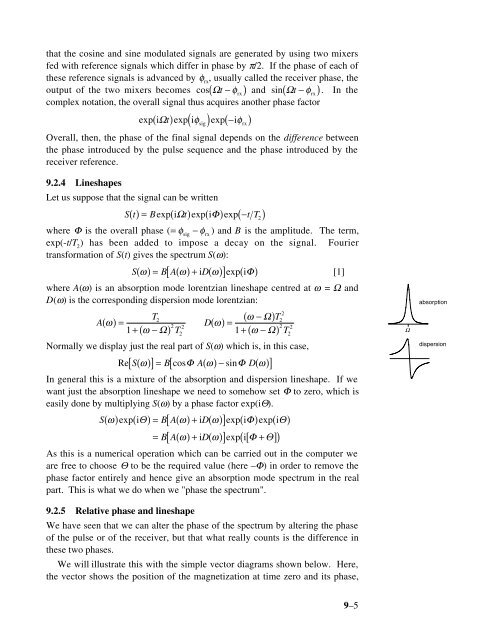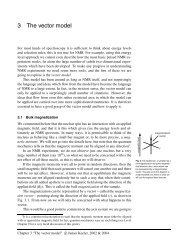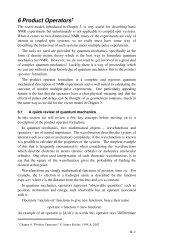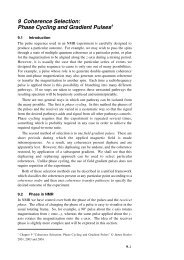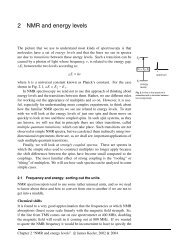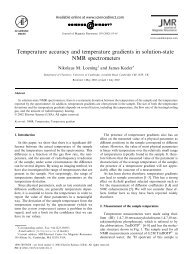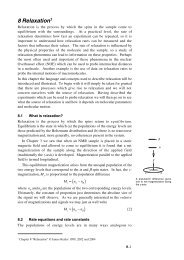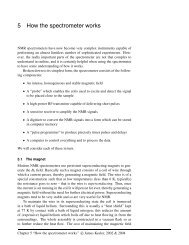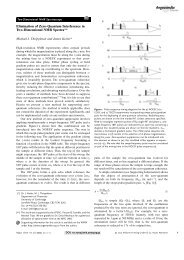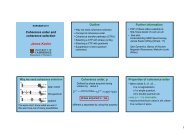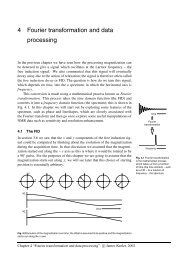Phase Cycling and Gradient Pulses - The James Keeler Group
Phase Cycling and Gradient Pulses - The James Keeler Group
Phase Cycling and Gradient Pulses - The James Keeler Group
Create successful ePaper yourself
Turn your PDF publications into a flip-book with our unique Google optimized e-Paper software.
that the cosine <strong>and</strong> sine modulated signals are generated by using two mixers<br />
fed with reference signals which differ in phase by π/2. If the phase of each of<br />
these reference signals is advanced by φ rx<br />
, usually called the receiver phase, the<br />
output of the two mixers becomes cos( Ωt − φ rx ) <strong>and</strong> sin( Ωt − φ rx ). In the<br />
complex notation, the overall signal thus acquires another phase factor<br />
( ) ( ) −<br />
exp iΩt<br />
exp iφ<br />
exp iφ<br />
sig<br />
( )<br />
Overall, then, the phase of the final signal depends on the difference between<br />
the phase introduced by the pulse sequence <strong>and</strong> the phase introduced by the<br />
receiver reference.<br />
9.2.4 Lineshapes<br />
Let us suppose that the signal can be written<br />
St ()= Bexp( iΩt) exp( iΦ) exp( −tT2<br />
)<br />
where Φ is the overall phase (= φsig<br />
−φrx ) <strong>and</strong> B is the amplitude. <strong>The</strong> term,<br />
exp(-t/T 2<br />
) has been added to impose a decay on the signal. Fourier<br />
transformation of S(t) gives the spectrum S(ω):<br />
S( ω)= B[ A( ω)+ iD( ω)<br />
] exp( iΦ )<br />
[1]<br />
where A(ω) is an absorption mode lorentzian lineshape centred at ω = Ω <strong>and</strong><br />
D(ω) is the corresponding dispersion mode lorentzian:<br />
2<br />
T2<br />
ω − Ω T2<br />
A( ω)= D( ω)=<br />
+ ( ω − )<br />
2 2<br />
2 2<br />
1 Ω T2<br />
1+ ( ω −Ω)<br />
T2<br />
Normally we display just the real part of S(ω) which is, in this case,<br />
rx<br />
( )<br />
[ ( )]= ( )− ( )<br />
[ ]<br />
Re S ω B cosΦ<br />
A ω sinΦ<br />
D ω<br />
In general this is a mixture of the absorption <strong>and</strong> dispersion lineshape. If we<br />
want just the absorption lineshape we need to somehow set Φ to zero, which is<br />
easily done by multiplying S(ω) by a phase factor exp(iΘ).<br />
S( ω) exp( iΘ)= B[ A( ω)+ iD( ω)<br />
] exp( iΦ) exp( iΘ)<br />
= BA( ω)+ iD( ω)<br />
exp i Φ Θ<br />
[ ] ( [ + ])<br />
As this is a numerical operation which can be carried out in the computer we<br />
are free to choose Θ to be the required value (here –Φ) in order to remove the<br />
phase factor entirely <strong>and</strong> hence give an absorption mode spectrum in the real<br />
part. This is what we do when we "phase the spectrum".<br />
9.2.5 Relative phase <strong>and</strong> lineshape<br />
We have seen that we can alter the phase of the spectrum by altering the phase<br />
of the pulse or of the receiver, but that what really counts is the difference in<br />
these two phases.<br />
We will illustrate this with the simple vector diagrams shown below. Here,<br />
the vector shows the position of the magnetization at time zero <strong>and</strong> its phase,<br />
Ω<br />
absorption<br />
dispersion<br />
9–5


